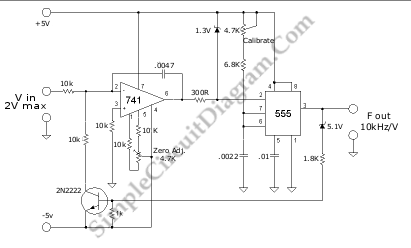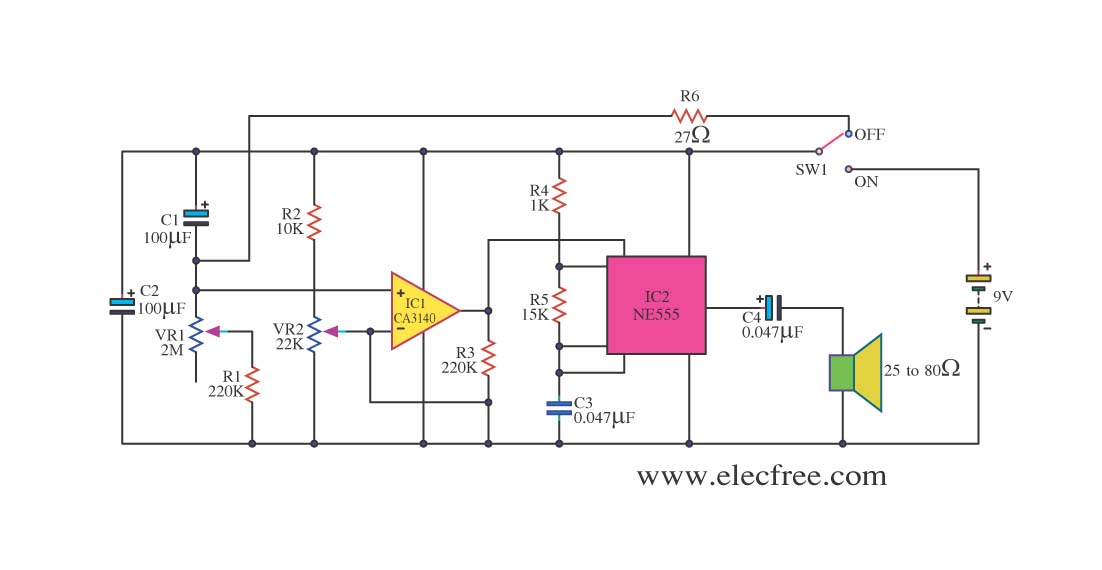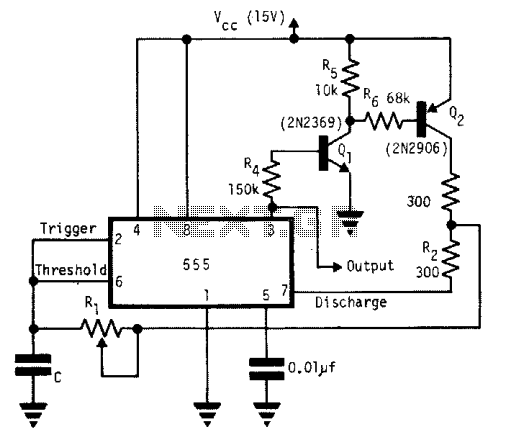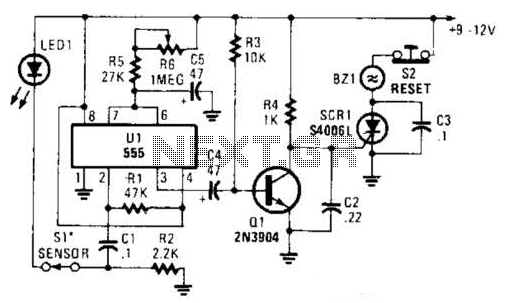
Designing 555 Astables
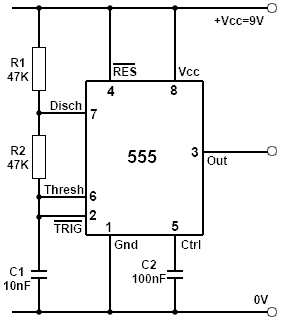
If an oscillator of a specific frequency and mark-to-space ratio is needed, the periodic time can be calculated from the required frequency, as well as the discharge and charge times using the formulas for tD and tC outlined in the Oscillators Module. Component details will be necessary, starting with capacitor C1. A suitable value can be estimated from the provided diagram, which indicates that for an astable configuration with a frequency of 1 kHz and a periodic time of 1 ms, capacitors ranging from 1 nF to 1 µF would be appropriate, depending on the total resistance selected. Manufacturers typically specify a maximum total resistance of around 10 to 20 MΩ for their 555 timer variants; however, using such high values may increase the discrepancy between calculated and actual frequencies, thus a maximum of 1 MΩ is recommended for many applications. The minimum total resistance value for the combination of R1 and R2 largely depends on R1. The junction of R1 and R2 connects to pin 6 and the trigger input pin 2. If R1 is less than approximately 1 kΩ, there is a risk that the trigger input may not reach a sufficiently low voltage to activate comparator 1, preventing oscillations. Therefore, R1 should be at least 1 kΩ, and R1 + R2 should remain below 1 MΩ; a 10 nF capacitor would yield a suitable total resistance of around 100 kΩ. The basic 555 astable design utilizes two timing resistors to generate square waves. During the high (charging) period, the timing capacitor (C1) charges through R1 and R2, while only R2 is used for discharging C1. Consequently, the resistance used for timing the high period must always exceed that of the low period, ensuring the high period is longer than the low period. Thus, the basic 555 astable configuration produces square waves that can approach but never achieve a 1:1 mark-to-space ratio. The mark-to-space ratio of a square wave or pulse oscillator is often referred to as the duty cycle. This term is more relevant when the output wave is used to drive devices such as motors, as it provides a more meaningful comparison to the power supplied to the motor than the mark-to-space ratio. Altering the duty cycle modifies the average DC voltage or current level of the output, affecting the power supplied to control the speed of the motor, which is also significant for driving output devices like lamps and heaters. The duty cycle represents the percentage of each cycle occupied by the active or high period. For example, a square wave with a 1:1 mark-to-space ratio has a duty cycle of 50%, meaning the high period constitutes 50% of the total period. In waveforms illustrating negative-going pulses, the duty cycle may be around 80%, while for positive-going pulses, it may be approximately 20%. Although the basic 555 astable configuration is limited to producing outputs with duty cycles greater than 50%, one advantage of using the 555 timer as an astable oscillator is the ease of modifying the circuit to achieve a broader range of duty cycles. For a completely symmetrical output wave (50% duty cycle), an alternative circuit can be employed. In this configuration, the timing capacitor connects to pins 2 and 6 as in the basic astable circuit, but a single timing resistor is now connected to the output (pin 3). During the high period, C1 charges from the high output via R1 until the voltage at pin 6 reaches 2/3 Vcc, triggering comparator 1. The output then goes low, and C1 discharges through R1 until the voltage at pin 2 drops to 1/3 Vcc, at which point comparator 2 triggers and initiates a new charging period. Since only one resistor is used for both charge and discharge in this configuration, the charge and discharge times become equal, yielding a simplified formula for the approximate frequency of oscillation. However, this solution for achieving a 50% duty cycle has some drawbacks. The circuit may not consistently produce a 50% duty cycle due to the assumption that the output of the 555 transitions between 0V and Vcc, while in reality, the output voltage can vary depending on the load. For instance, with a 9V supply, the output may fluctuate between 0V and slightly over 8V, and this variation can affect the timing capacitor's charge rate. Consequently, differences in timing may arise as the voltages at pin 3 and Vcc do not match, impacting both frequency and mark-to-space ratio. Nevertheless, performance can be enhanced through various methods. Pin 5 of the 555 is the control pin, which often serves to decouple the inverting input of comparator 1 to prevent noise from causing incorrect triggering. However, this pin can also be utilized as a control input, allowing for adjustments to the frequency and duty cycle when the 555 operates in astable mode. The control input connects to the resistor chain in the IC that determines the 2/3 and 1/3 Vcc trigger points. By applying a DC voltage to pin 5, the internal trigger points can be modified, altering the charge and discharge periods of the generated wave. Measuring the voltage at pin 5 typically reveals a value of 2/3 Vcc; applying a higher voltage increases the charge period, thereby reducing the frequency, while a lower voltage shortens the charge period and increases the frequency. Thus, pin 5 offers a method for adjusting the oscillation frequency through an external DC voltage, and it can be effectively decoupled with a large capacitor, allowing the frequency control potentiometer to be positioned away from the oscillator without introducing noise. Simple control over the duty cycle can be implemented in the basic 555 astable circuit by utilizing the control input. A potentiometer (VR1) can apply a variable voltage to pin 5, with limits set by R1 and R2 to prevent the control voltage from reaching +Vcc or 0V, thereby enabling duty cycle adjustments above and below 50%. However, using the control pin in this manner affects both duty cycle and frequency simultaneously. A circuit designed to provide an adjustable duty cycle with minimal frequency impact is a modified version of the 50% duty cycle circuit. In this configuration, VR1 allows for continuous duty cycle adjustments between approximately 35% and 75%, avoiding the control input and enabling duty cycle modification with negligible frequency effects. The two sections of VR1, positioned on either side of the slider, form separate adjustable timing resistors. During the charge period, diode D1 conducts when the output on pin 3 is high, providing a timing resistance composed of R3, the left portion of VR1, and R1. During the discharge period, when pin 3 is low, D1 becomes reverse-biased, and diode D2 provides a discharge path through R2, the right portion of VR1, and R3. The frequency is calculated using the same formula as for the 50% duty cycle circuit, although it may be slightly affected by the diodes' forward resistance. In this circuit, the resistance is now made up of R3 plus half of VR1 plus R2 (or R1, which is equivalent). Frequencies ranging from fractions of 1 Hz to many tens of kHz can be achieved by selecting appropriate values for the timing capacitor C1 and resistor R3, with R1 and R2 kept equal in value.If an oscillator of a particular frequency and mark to space ratio is required, (see Fig. 4. 4. 1) the method would be to calculate periodic time from the required frequency and the discharge time and charge time using the formulae for tD and tC described in Oscillators Module 4. 3. To do this, some component details will be needed. Starting with C1 , a suitable value can be assumed from the diagram in Fig. 4. 4. 2, which shows that for an astable having a frequency of 1kHz, and so for a periodic time of 1ms, capacitors of 1nF to 1 F would suffice, depending on which of the total resistances (indicated by the red lines) was chosen. Manufacturers specify the maximum total resistance that may be used with their particular variant of the 555, and these maximum values are usually around 10 to 20M ©, however using such high values can increase the error between calculated and actual frequencies, so for many uses a 1M © maximum can be recommended.
The minimum total resistance value for the combination of R1 and R2 depends largely on the value of R1. The junction of R1/R2 is connected to pin 6 and to the trigger input pin 2. If the value of R1 is less than about 1K ©, there is a danger that the trigger input may not be able reach a low enough voltage to trigger comparator 1, and so oscillations cannot take place.
From this it can be assumed that if R1 must be 1K © or above and R1 + R2 should be kept below 1M ©; a 10nF capacitor would allow a suitable total resistance of around 100K © to be calculated. The basic 555 astable design described above uses two timing resistors when producing square waves. In timing the high (charging) period the timing capacitor (C1 in Fig. 4. 4. 3) is charged via R1 and R2, but only R2 is used whilst discharging C1. In this basic configuration, the resistance used for timing the high period must always be greater than that used during the low period.
The high period of the wave must therefore always be longer than the low period. It follows that the basic version of the 555 astable produces square waves than can be nearly, but never quite 1:1 mark space ratio square waves. The mark to space ratio of a square wave or pulse oscillator is often referred to as the Duty Cycle. This is a more useful term when the purpose of an output wave is to drive some device such as a motor.
It gives a more useful comparison to the power supplied to the motor than describing the mark to space ratio of the output. Changing the duty cycle changes the average DC voltage or DC current level of the output, as shown in Fig.
4. 4. 5 and hence the power supplied to control the speed of the motor. This is also important in driving output devices such as lamps, heaters and many others. The Duty Cycle is a term that describes the percentage of each cycle taken up by the active or high period. For example a square wave with a mark to space ratio of 1:1 has a duty cycle of 50% so the high period takes up 50% of the total period.
In the waveform illustrating negative going pulses in Fig. 7 the duty cycle may be about 80% while in the positive going pulse waveform, the duty cycle may be around 20%. Although the basic form of the 555 astable is limited to producing an output with a duty cycle that is always greater than 50%, one of the great benefits of using the 555 timer as an astable oscillator is the ease with which the circuit can be modified to produce a much wider range of duty cycle.
Where a completely symmetrical output wave (50% duty cycle) is required, an alternative method is to use the circuit shown in Fig. 8. In this configuration, shown using the pin-out of the actual 555 IC, the timing capacitor is still connected to pins 2 and 6 as in the basic astable circuit, but a single timing resistor is now connected to the output, pin 3.
During the high period of the waveform C1 charges from the high output via R1 until the voltage at pin 6 reaches 2/3Vcc and triggers comparator 1. The output now goes low and C1 discharges via R1 until the voltage at pin 2 falls to 1/3Vcc when comparator 2 triggers and starts a new charging period.
As only one resistor is used for charge and discharge in Fig. 4. 4. 6 both charge and discharge times are now identical at 0. 7CR, which gives a simplified formula for the approximate frequency of oscillation. There are however, some drawbacks to this solution for obtaining a 50% duty cycle. Surprisingly the circuit may not always produce a 50% duty cycle. One reason for this is that the design assumes that the output of the 555 changes between 0V and Vcc, but in practice the actual output voltage depends to some extent on the load placed on the output. It is common for example, that in a 555 with a 9V supply the output may change between 0V and just a little over 8V, and with different load resistances, this difference between Vcc and output voltage may again vary.
The trigger points at which the 555 IC switches its output are a fixed proportion of Vcc because they are supplied from the three internal resistors between +Vcc and 0V, but the rate at which the timing capacitor in this design charges now depends, not on Vcc as in the basic design, but on the output voltage. Therefore differences in timing can occur because the voltages at the output pin 3 and at Vcc are not the same, this can affect both the frequency and mark to space ratio.
However performance can be improved in a number of ways to make a number of useful circuits. Pin 5 of the 555 is the Control (Ctrl) pin, which in many applications serves only to decouple the inverting input of comparator 1 inside the IC to prevent noise causing incorrect triggering of the circuit. However, this pin can also function as a useful input, allowing the control of the frequency and duty cycle when the 555 is used in astable mode.
The control input is also connected to the resistor chain in the IC that controls the 2/3 and 1/3Vcc trigger points of the circuit. Therefore by externally applying a DC voltage to pin 5, the internally set trigger points can be altered to lengthen or shorten the charge and discharge periods of the generated wave.
Measuring the voltage on pin 5 would normally show a voltage of 2/3Vcc, and applying a higher voltage than this would increase the time of the charge period as the timing capacitor has to now reach this higher voltage before comparator 1 triggers. Therefore the higher the voltage on pin 5 the longer the charge period and the lower the frequency of the wave.
Reducing the voltage on pin 5 below its normal 2/3Vcc will cause the charge period to shorten and the frequency to increase. Pin 5 therefore provides a method of changing the frequency of oscillation by applying a DC voltage, and since pin 5 can still be effectively decoupled by quite a large value of decoupling capacitor, the potentiometer for controlling the frequency can be located some distance from the oscillator without the problem of introducing noise to the circuit.
Fig. 4. 4. 7 shows how simple control over the duty cycle can be implemented in the basic 555 astable circuit by the use of the control input. A potentiometer VR1 is used to apply a variable voltage to pin 5. The limits of variation is set by R1 and R2 so that the control voltage is not allowed to swing to +Vcc or to 0V, allowing the duty cycle to be adjusted over a range above and below 50%.
One problem with using the control pin in this way is that it affects both the duty cycle and the frequency at the same time. A circuit providing an adjustable duty cycle with a minimal effect on frequency is shown in Fig 4. 4. 8. This is a modified version of the 50% duty cycle circuit shown in Fig. 4. 4. 6. VR1 provides a continually adjustable duty cycle between approximately 35% and 75% avoiding use of the control input therefore allowing adjustment of the duty cycle with little or no effect on the frequency of oscillation.
The two sections of VR1, either side of the slider, added to R1 and R2 effectively provide two separate (and adjustable) values of timing resistor. D1 conducts during the charge period of C1 when the output on pin 3 is high, providing a timing resistance made up of R3, the left hand portion of VR1, and R1.
During the discharge period pin 3 is low, so D1 is reverse biased; D2 now provides a discharge path via R2, the right hand portion of VR1, and R3. The frequency is calculated using the same formula as for the 50% duty cycle circuit shown in Fig. 4. 4. 6, although this will be slightly affected by the forward resistance of the diodes: Also, in this circuit R is now made up of R3 + half of VR1 + R2 (or R1, which is the same value).
Frequencies from a fraction of 1Hz to many tens of kHz can be obtained from Fig 4. 4. 8 by using different combinations of values for the timing capacitor C1 and resistor R3 by a suitable choice of C1. R1 and R2 should be kept equal in value. 🔗 External reference
The minimum total resistance value for the combination of R1 and R2 depends largely on the value of R1. The junction of R1/R2 is connected to pin 6 and to the trigger input pin 2. If the value of R1 is less than about 1K ©, there is a danger that the trigger input may not be able reach a low enough voltage to trigger comparator 1, and so oscillations cannot take place.
From this it can be assumed that if R1 must be 1K © or above and R1 + R2 should be kept below 1M ©; a 10nF capacitor would allow a suitable total resistance of around 100K © to be calculated. The basic 555 astable design described above uses two timing resistors when producing square waves. In timing the high (charging) period the timing capacitor (C1 in Fig. 4. 4. 3) is charged via R1 and R2, but only R2 is used whilst discharging C1. In this basic configuration, the resistance used for timing the high period must always be greater than that used during the low period.
The high period of the wave must therefore always be longer than the low period. It follows that the basic version of the 555 astable produces square waves than can be nearly, but never quite 1:1 mark space ratio square waves. The mark to space ratio of a square wave or pulse oscillator is often referred to as the Duty Cycle. This is a more useful term when the purpose of an output wave is to drive some device such as a motor.
It gives a more useful comparison to the power supplied to the motor than describing the mark to space ratio of the output. Changing the duty cycle changes the average DC voltage or DC current level of the output, as shown in Fig.
4. 4. 5 and hence the power supplied to control the speed of the motor. This is also important in driving output devices such as lamps, heaters and many others. The Duty Cycle is a term that describes the percentage of each cycle taken up by the active or high period. For example a square wave with a mark to space ratio of 1:1 has a duty cycle of 50% so the high period takes up 50% of the total period.
In the waveform illustrating negative going pulses in Fig. 7 the duty cycle may be about 80% while in the positive going pulse waveform, the duty cycle may be around 20%. Although the basic form of the 555 astable is limited to producing an output with a duty cycle that is always greater than 50%, one of the great benefits of using the 555 timer as an astable oscillator is the ease with which the circuit can be modified to produce a much wider range of duty cycle.
Where a completely symmetrical output wave (50% duty cycle) is required, an alternative method is to use the circuit shown in Fig. 8. In this configuration, shown using the pin-out of the actual 555 IC, the timing capacitor is still connected to pins 2 and 6 as in the basic astable circuit, but a single timing resistor is now connected to the output, pin 3.
During the high period of the waveform C1 charges from the high output via R1 until the voltage at pin 6 reaches 2/3Vcc and triggers comparator 1. The output now goes low and C1 discharges via R1 until the voltage at pin 2 falls to 1/3Vcc when comparator 2 triggers and starts a new charging period.
As only one resistor is used for charge and discharge in Fig. 4. 4. 6 both charge and discharge times are now identical at 0. 7CR, which gives a simplified formula for the approximate frequency of oscillation. There are however, some drawbacks to this solution for obtaining a 50% duty cycle. Surprisingly the circuit may not always produce a 50% duty cycle. One reason for this is that the design assumes that the output of the 555 changes between 0V and Vcc, but in practice the actual output voltage depends to some extent on the load placed on the output. It is common for example, that in a 555 with a 9V supply the output may change between 0V and just a little over 8V, and with different load resistances, this difference between Vcc and output voltage may again vary.
The trigger points at which the 555 IC switches its output are a fixed proportion of Vcc because they are supplied from the three internal resistors between +Vcc and 0V, but the rate at which the timing capacitor in this design charges now depends, not on Vcc as in the basic design, but on the output voltage. Therefore differences in timing can occur because the voltages at the output pin 3 and at Vcc are not the same, this can affect both the frequency and mark to space ratio.
However performance can be improved in a number of ways to make a number of useful circuits. Pin 5 of the 555 is the Control (Ctrl) pin, which in many applications serves only to decouple the inverting input of comparator 1 inside the IC to prevent noise causing incorrect triggering of the circuit. However, this pin can also function as a useful input, allowing the control of the frequency and duty cycle when the 555 is used in astable mode.
The control input is also connected to the resistor chain in the IC that controls the 2/3 and 1/3Vcc trigger points of the circuit. Therefore by externally applying a DC voltage to pin 5, the internally set trigger points can be altered to lengthen or shorten the charge and discharge periods of the generated wave.
Measuring the voltage on pin 5 would normally show a voltage of 2/3Vcc, and applying a higher voltage than this would increase the time of the charge period as the timing capacitor has to now reach this higher voltage before comparator 1 triggers. Therefore the higher the voltage on pin 5 the longer the charge period and the lower the frequency of the wave.
Reducing the voltage on pin 5 below its normal 2/3Vcc will cause the charge period to shorten and the frequency to increase. Pin 5 therefore provides a method of changing the frequency of oscillation by applying a DC voltage, and since pin 5 can still be effectively decoupled by quite a large value of decoupling capacitor, the potentiometer for controlling the frequency can be located some distance from the oscillator without the problem of introducing noise to the circuit.
Fig. 4. 4. 7 shows how simple control over the duty cycle can be implemented in the basic 555 astable circuit by the use of the control input. A potentiometer VR1 is used to apply a variable voltage to pin 5. The limits of variation is set by R1 and R2 so that the control voltage is not allowed to swing to +Vcc or to 0V, allowing the duty cycle to be adjusted over a range above and below 50%.
One problem with using the control pin in this way is that it affects both the duty cycle and the frequency at the same time. A circuit providing an adjustable duty cycle with a minimal effect on frequency is shown in Fig 4. 4. 8. This is a modified version of the 50% duty cycle circuit shown in Fig. 4. 4. 6. VR1 provides a continually adjustable duty cycle between approximately 35% and 75% avoiding use of the control input therefore allowing adjustment of the duty cycle with little or no effect on the frequency of oscillation.
The two sections of VR1, either side of the slider, added to R1 and R2 effectively provide two separate (and adjustable) values of timing resistor. D1 conducts during the charge period of C1 when the output on pin 3 is high, providing a timing resistance made up of R3, the left hand portion of VR1, and R1.
During the discharge period pin 3 is low, so D1 is reverse biased; D2 now provides a discharge path via R2, the right hand portion of VR1, and R3. The frequency is calculated using the same formula as for the 50% duty cycle circuit shown in Fig. 4. 4. 6, although this will be slightly affected by the forward resistance of the diodes: Also, in this circuit R is now made up of R3 + half of VR1 + R2 (or R1, which is the same value).
Frequencies from a fraction of 1Hz to many tens of kHz can be obtained from Fig 4. 4. 8 by using different combinations of values for the timing capacitor C1 and resistor R3 by a suitable choice of C1. R1 and R2 should be kept equal in value. 🔗 External reference

